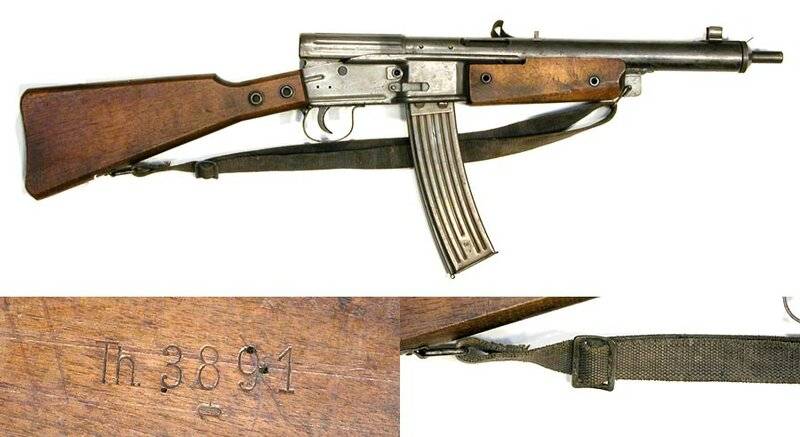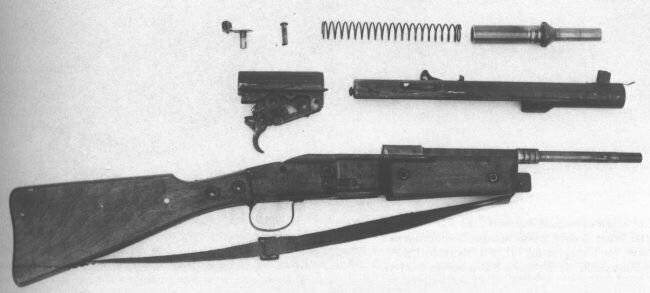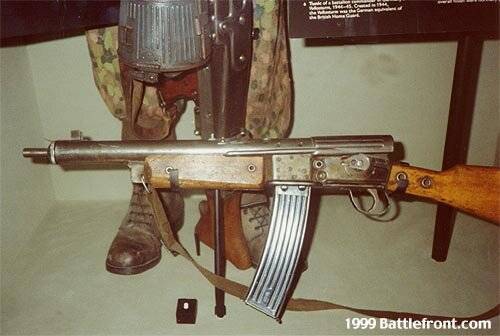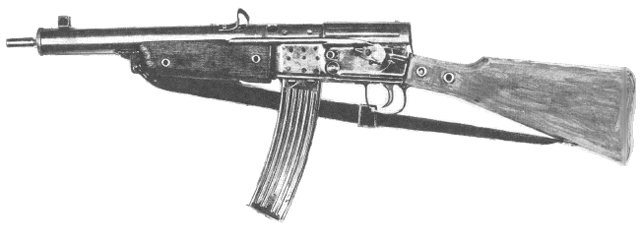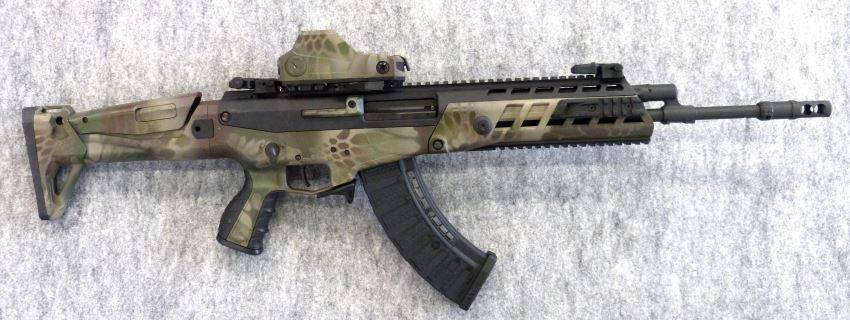Los VG 1, 2 y 5
El Volkssturmgewehr VG 1 era un fusil de cerrojo. Emplea un sencillo cerrojo rotativo, que se cierra gracias a sus dos tetones de acerrojado frontales; la tosca manija del cerrojo encajaba en un entalle del cajón de mecanismos de acero fundido para ofrecer seguridad adicional. Era alimentado mediante cargadores extraíbles, originalmente desarrollados para el Gewehr 43. Su seguro manual también era muy tosco, consistiendo en una palanca de acero estampado unida al guardamonte con un pasador y ubicada detrás del gatillo. Al activarse, el seguro bloquea el movimiento del gatillo. Para desactivarlo, el tirador debe girarlo a un lado con su dedo. La tosca culata es de madera y sus mecanismos de puntería fijos solamente permitían disparos a corta distancia. Iba a ser producido por la Zbrojovka Brno en la actual República Checa.
El Volkssturmgewehr VG 2 también es un fusil de cerrojo, con un cerrojo rotativo similar y tosco seguro manual. El acerrojado se efectuaba por dos tetones frontales que se encajaban en unos entalles remachados dentro del cajón de mecanismos de chapa de acero estampada. Era alimentado mediante cargadores extraíbles, originalmente desarrollados para el Gewehr 43. La culata y el guardamanos son de madera, con un acabado tosco. Ambos están remachados al cajón de mecanismos. Sus mecanismos de puntería fijos solamente permitían disparos a corta distancia, estando fijados para 100 m.
El VG 5, o más corréctamente Volkssturmkarabiner VK 98, era aún más básico. Empleaba el cerrojo del Mauser 98, pero no tenía depósito, siendo un fusil monotiro donde cada cartucho debía ser introducido manualmente en la recámara. Sus mecanismos de puntería eran fijos.
Estos prototipos de fusiles fueron desarrollados como parte del programa Volkssturm-Mehrladegewehr.
Gustloff Volkssturmgewehr
The Gustloff Volkssturmgewehr (right), shown here next to an MG 42 (left)
Volkssturm soldiers in an emplacement along the Oder river in 1945. The soldier on the left is carrying a Gustloff Volkssturmgewehr.
The Gustloff Volkssturmgewehr was designed by Karl Barnitzke of the Gustloff-Werke for the Primitiv-Waffen-Programm (“primitive weapons program”) in 1944 and was intended to be used by the Volkssturm. Production of the Gustloff Volkssturmgewehr occurred from January 1945 till the end of the war; roughly 10,000 were made.
This gun was initially called MP 507. The MP 508 was fairly similar except it had a semi-pistol grip stock.
The weapon employed the same 7.92×33mm Kurz intermediate cartridge as the earlier StG 44 assault rifle and also used the same detachable 30-round .
The Gustloff Volkssturmgewehr uses a gas-delayed blowback action based on the Barnitzke system, whereby gas bled from the barrel near the chamber creates resistance to the rearward impulse of the operating parts, which ceases when the projectile leaves the muzzle, allowing the operating parts to be forced rearward by the residual pressure of the cartridge case. This principle has been used most successfully in the Heckler & Koch P7 pistol.
The Gustloff Volkssturmgewehr is constructed rather like many semi-automatic pistols, it has a casing and spring around the barrel; the whole casing recoils backward. The breech block, with firing pin and extractor, is pinned to the back end of the barrel casing. The rear end of the gun does not recoil and has the hammer, sear and trigger built into it. Gas coming from four vents, near the end of the barrel, holds the bolt closed till the gas pressure drops to a safe level. Some selective fire Gustloff Volkssturmgewehrs were made[citation needed].
The Grossfuss Sturmgewehr used the same principle of gas-delayed blowback operation, but it was somewhat more efficient in the use of gas; its bolt weighed 0.8-0.9 kg compared to 1.4 kg in the Gustloff Volkssturmgewehr.
The Gustloff Volkssturmgewehr was assembled out of 39 metallic parts, not counting rivets and screws. Of these specific parts, 12 required milling, 21 could be produced by stamping alone, and 6 were springs.
Testing of a captured Gustloff Volkssturmgewehr at a Soviet GAU shooting range showed that it was rather inaccurate, with 50% of the shots at 100 m landing in a circle with 10.2 cm radius and with 100% of the shots at the same distance landing in a circle with a 19.8 cm radius. At 300 m these the corresponding radii were respectively 25 and 50.3 cm.
The 100 meter fixed sights of the Gustloff Volkssturmgewehr made aiming difficult at longer ranges, with the bullet dropping -91 cm (-36 inches) below line of sight at 300 meters, forcing the shooter to aim higher on the target. Keeping in mind that a kneeling enemy soldier presents a target apx 96 cm (38 inches) in height, and a prone target apx 48 cm (19 inches) in height.
Primitiv-Waffen-Programm
As a last-ditch measure in the nearly lost war, on 18 October 1944 the Deutscher Volkssturm was mobilized – a German national militia. To arm them under conditions of depleted manpower and limited available production capacities the Primitiv-Waffen-Programm (“primitive weapons program”) was initiated. It called for weapons that were as easy as possible to produce. Walther designed the Volkssturmgewehr VG 1 rifle, Spreewerk Berlin the VG 2, Rheinmetall the VG 3, Mauser the VG 4 and Steyr the VG 5 (a.k.a. VK 98). Best known is the Volkssturmgewehr by Gustloff which was a gas-delayed blowback semi-automatic rifle.
El Primitiv-Waffen Programm
Como una medida desesperada en la casi perdida guerra, el 18 de octubre de 1944 se movilizó al Volkssturm – una milicia nacional alemana. Para armarlos en las condiciones de pocos hombres disponibles y limitada capacidad productiva, se inició el Primitiv-Waffen-Programm (Programa de armas primitivas). Fue llamado así, porque las armas debían ser lo más sencillas posibles de producir. La Walther diseñó el fusil Volkssturmgewehr VG 1, la Spreewerk Berlin el VG 2, la Rheinmetall el VG 3, la Mauser el VG 4 y la Steyr Mannlicher el VG 5 (también conocido como el VK 98). El fusil más conocido es el Volkssturmgewehr de la Gustloff, que era un fusil semiautomático accionado mediante retroceso retardado por gas.
Проекты
Mauser
Еще в 1943 году инженеры фирмы Mauser Зайдель, Альтенбургер и Штарнаанс начали разработку похожих проектов. С начала 1944 года по март-апрель 1945 года они разрабатывали множество экспериментальных моделей пистолетов Mauser, которые должны были прийти на замену Walther P38. В октябре 1944 года команда Mauser-Werke разработала новый пистолет для фольксштурма, получивший обозначение Mauser V.7082. Автоматика пистолета работала по принципу полусвободного затвора, как в Mauser HSc. Для стрельбы предлагались патроны 9×19 мм «Парабеллум», отдача которых за счёт полусвободного затвора полностью нейтрализовывалась, что позволяло использовать в перспективе и более мощные патроны. По причине нехватки ресурсов и времени пистолет был выполнен на низком техническом уровне и остался в опытном образце. Позднее некоторые наработки этого пистолета использовались для создания нового немецкого пистолета HK P7 и австрийского пистолета Steyr GB.
Walther
Пистолеты со штампованными деталями производились ещё в 1930-е годы. В ноябре 1944 года два варианта Volkspistole представила фирма Walther на испытания: у них были самовзводные ударно-спусковые механизмы. Один из таких пистолетов работал по принципу вращающегося ствола при коротком ходе. Второй располагал автоматикой, которая использовала отдачу при коротком ходе ствола со снижением. В качестве основных узлов брались элементы пистолетов Walther P38 и Browning Hi-Power. Максимально простые штампо-сварные конструкции позволяли наладить массовое производство и снизить затраты. Однако такая конструкция была довольно сложной. На испытания вскоре отправили ещё два варианта, созданные по штампо-сварным технологиям и имевшим свободный затвор (у одного из вариантов был самовзводный ударно-спусковой механизм, у другого — несамовзводный).
Gustloff-Werke
Разработчиком варианта от Gustloff-Werke стал Виктор Барницке. Автоматика его пистолета «9 mm Pistole P.44», изготовленного на прессо-штамповочном оборудовании, использовала принцип торможения затвора пороховыми газами, отводимыми из канала ствола. Были полусвободный затвор с замедлением пороховыми газами, которые воздействовали на поршень и тормозящий отход кожух затвора до вылета пули из канала ствола. Все детали, кроме ствола и поршня, выполнялись штамповкой.
VG 1, 2 and 5
VG 1
The Walther Volkssturmgewehr VG 1 is a manually operated bolt-action rifle. It uses a simple rotating bolt, with locking provided by the two frontal lugs; the crude bolt handle engages a cut in the cast steel receiver to provide additional safety. The feed is from detachable 10-round box magazines, originally developed for the Gewehr 43 rifle. The manual safety is also very crude, and consist of a stamped steel lever pinned to the trigger guard just behind the trigger. When engaged, the safety lever blocks trigger movement. To disengage the safety the user must turn it sideways with a finger. The stock is crudely made from wood, and non-adjustable iron sights are provided for close-range shooting only. It was meant to be produced by Zbrojovka Brno in the current-day Czech Republic.
VG 2
The Spreewerk Berlin Volkssturmgewehr VG 2 is also a manually operated bolt-action rifle with a similar rotating bolt and crude manual safety. Locking is provided by two frontal lugs which lock into the steel insert pinned inside the stamped steel receiver. The VG 2 rifle is fed from detachable box magazines, originally developed for Gewehr 43. The stock is crudely made from wood and consists of two separate parts: shoulder stock with semi-pistol grip and fore-end. Wood parts are permanently pinned to the receiver. Non-adjustable iron sights are provided for close-range shooting only, and zeroed for 100 metres (110 yd).
VG 5
The Steyr Volkssturmgewehr VG 5 rifle (or more correctly, the Volkssturmkarabiner VK 98) was slightly less basic. It used the Mauser Gewehr 98 type bolt action with rotary bolt, some of the early guns actually had serialised K98 bolts and/or receivers probably sourced from parts storages or rejected from main production for some reasons. Later guns had more parts produced specifically for VG5, these were standard K98 parts, but of very low quality, they were obviously distinguishable by virtually lacking any finish. The barrels were actually all K98 standard barrels. It had an internal magazine, just like K98, though with simpler unremovable bottom plate, very basic unadjustable fixed sights and very simple short stock, making it indeed a simplified and low quality sporter stocked K98.
These rifle prototypes were developed as part of the Volkssturm-Mehrladegewehr (“People’s Assault Repeating Rifle”) program.
El Volksstumgewehr Gustloff
Soldados del Volkssturm en una trinchera junto al Oder en 1945. El soldado de la izquierda lleva un Volkssturmgewehr Gustloff.
El Volksstumgewehr Gustloff fue diseñado en 1944 por Karl Barnitzke de la Gustloff-Werke, para el Primitiv-Waffen-Programm, ideado para ser empleado por el Volkssturm. La producción del Volksstumgewehr Gustloff tuvo lugar desde enero de 1945 hasta el final de la guerra; apenas se fabricaron 10.000.
Inicialmente el fusil fue llamado MP 507. El MP 508 era bastante similar, excepto por tener un pistolete.
El arma empleaba el mismo cartucho intermedio 7,92 x 33 Kurz del anterior fusil de asalto StG 44, así como el mismo cargador extraíble de 30 balas.
El Volkssturmgewehr Gustloff tenía un mecanismo de recarga mediante retroceso retardado por gas, basado en el sistema Barnitzke, donde el gas era desviado desde el cañón a la recámara para crear resistencia al movimiento hacia atrás de las piezas operativas, la cual cesa una vez que la bala abandona el cañón y permite que las piezas operativas vayan hacia atrás por la presión residual del casquillo. Este principio ha sido exitosamente empleado en la pistola HK P7.
El Volkssturmgewehr Gustloff estaba construido como muchas pistolas semiautomáticas, con una envoltura y el muelle recuperador rodeando al cañón; toda la envoltura iba hacia atrás al disparar. El cerrojo, con percutor y extractor, estaba unido al extremo posterior de la envoltura del cañón. La parte posterior del fusil no retrocedía, ya que en esta se encontraban el martillo, la barra de transferencia y el gatillo. El gas era dirigido a través de cuatro aberturas, situadas cerca de la boca del cañón, manteniendo el cerrojo cerrado hasta que la presión de los gases baje a un nivel seguro. Se fabricaron algunos Volkssturmgewehr Gustloff con mecanismo selector de disparo.
El Sturmgewehr Grossfuss empleaba el mismo principio de retroceso retardado por gas, pero era algo más eficiente en el empleo del gas; su cerrojo pesaba 0,8-0,9 kg en comparación con el cerrojo de 1,4 kg del Volkssturmgewehr Gustloff.
El Volkssturmgewehr Gustloff era ensamblado a partir de 39 piezas metálicas, sin contar los remaches y tornillos. De estas piezas específicas, 12 eran torneadas, 21 podían producirse simplemente por estampado y 6 eran resortes.
Las pruebas efectuadas con un Volkssturmgewehr Gustloff capturado en un polígono de tiro soviético del GRAU mostraron que era bastante impreciso, con 50% de los disparos a 100 m impactando en un círculo de 10,2 cm de radio y con el 100% de los disparos impactando en un círculo de 19,8 cm de radio a la misma distancia. A 300 m, el radio de los círculos era de 25 cm y 50,3 cm respectivamente. Los mecanismos de puntería fijos del Volkssturmgewehr Gustloff hacían que fuese difícil apuntar, porque el cartucho 7,92 x 33 Kurz se elevaba unos 29 cm sobre la línea de puntería a 100 m y caía a 43 cm debajo de ésta a 300 m.





